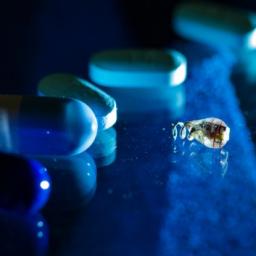
So, how y'all feeling? We can fix that.
DARPA, on the back of the US government's BRAIN program, has begun the development of
tiny electronic implants that interface directly with your nervous system and can directly control and regulate many different diseases and chronic conditions, such as arthritis, PTSD, inflammatory bowel diseases (Crohn's disease), and depression. The program, called ElectRx (pronounced 'electrics'), ultimately aims to replace medication with "closed-loop" neural implants, which constantly assess the state of your health, and then provide the necessary nerve stimulation to keep your various organs and biological systems functioning properly.
The old joke is that there's no need to study biology since eventually it's all just chemistry anyway. But maybe behind the chemistry it's actually all just electrical? If that's the case,
I'd like a USB port wired in, please.

Put aside the "Android is based on Linux" argument for a second, and let's look at the state of tablet hardware running the Linux operating system instead of Android. And it doesn't look good.
Network World reports
Ubuntu Touch might be our last and best hope for tablets running Linux:
Canonical says that they expect Ubuntu Touch-powered tablets to start shipping in the second half of this year. When I took Ubuntu Touch for a spin on my Nexus 7 last October, it definitely had promise (if it was a bit on the buggy side). And it has certainly improved a great deal since then. Unfortunately, the ability to run traditional Linux desktop software isn't the focus of Ubuntu Touch. In theory, this will be possible, but I've yet to see this actually happen. So I'm not holding my breath.
Not too long ago, Aaron Seigo and a group of KDE hackers was making a big splash about the upcoming
Vivaldi tablet, which was to be a Linux tablet running a customized version of the KDE Plasma environment (KDE4 reconfigured in ways that make sense for a tablet). I was looking forward to that device, as KDE4 was rejiggered specifically to permit this kind of innovation in interfaces and avoid the whole "if Gnome3 is good enough for a tablet it's good enough for your desktop" attitude. Unfortunately, when the Vivaldi tablet project met with a lack of supporters willing to put up cold hard cash, it bit the dust:
Announcing the 'wrap up' in an e-mail sent to backers of the Improv ARM-based development board the team suggests that the FOSS community is 'not ready' to put its weight behind the 'pressing issue of hardware freedom', adding: "We greatly appreciate everyone's support, whether it was purchases, donations or words of wisdom and encouragement. There was simply not enough support to make the project work, despite having fully functional, production ready devices and a strong commitment to succeed."
Well, there's still the
Pengpod, currently in crowd funding. But it's
barely there as a product, reliant on going from crowd-funding to crowd-funding to push out new versions of their interesting product. What is there to do if you want Linux apps on tablet hardware? For the moment, it seems the answer is "be patient."
Wednesday, Nature (a scientific journal focused on the natural science) reported something either astonishing or expected, depending on your own personal mood:
close to 4,000 species of microbes have been discovered growing in the cold, dark environment of
Subglacial Lake Whillans in western Antarctica. Each quarter teaspoon of the tea-colored lake water brought to the surface had about 130,000 cells in it.
In the lightless environment of Subglacial Lake Whillans, the microbes rely on minerals from the bedrock and sediments. The pressure of the slowly moving ice above the lake grinds the underlying rock into a powder, liberating the minerals in the rock into the water, and making them accessible to the microorganisms living there. The microbes act on those iron, ammonium and sulphide compounds to create energy.
From the LA Times:
Scientists have discovered a diverse ecosystem of single-celled organisms that have managed to survive without ever seeing the light of the sun. The discovery, reported Wednesday in the journal Nature is not so much a surprise as a triumph of science and engineering. The research team spent 10 years and more than $10 million to prove beyond a shadow of a doubt that life did indeed exist in sub-glacial lakes near the South Pole.
WikiLeaks has released previously unseen copies of weaponised German surveillance malware used by intelligence agencies around the world to spy on journalists, political dissidents and others."FinFisher (formerly part of the UK based Gamma Group International until late 2013) is a German company that produces and sells computer intrusion systems, software exploits and remote monitoring systems that are capable of intercepting communications and data from OS X, Windows and Linux computers as well as Android, iOS, BlackBerry, Symbian and Windows Mobile devices. FinFisher first came to public attention in December 2011 when WikiLeaks published documents detailing their products and business in the first SpyFiles release. ...
FinFisher continues to operate brazenly from Germany selling weaponised surveillance malware to some of the most abusive regimes in the world. The Merkel government pretends to be concerned about privacy, but its actions speak otherwise. Why does the Merkel government continue to protect FinFisher? This full data release will help the technical community build tools to protect people from FinFisher including by tracking down its command and control centers."
FinFisher Relay and FinSpy Proxy are the components of the FinFisher suite responsible for collecting the data acquired from the infected victims and delivering it to their controllers. It is commonly deployed by FinFisher's customers in strategic points around the world to route the collected data through an anonymizing chain, in order to disguise the identity of its operators and the real location of the final storage, which is instead operated by the FinSpy Master."
Let's go back in time to a couple of months ago when the German government was furious to learn the US had eavesdropped on Ms. Merkel's cellphone conversations. That anger looks a bit different now, mmmm?

With increasing industrial demand, rising prices, political and environmental concerns,
there's renewed interest in extracting valuable minerals from large bodies of salt water. The most profitable of these being lithium, due to demand for advanced batteries in portable electronics and electric vehicles. This is just a variation on a theme, as lithium "mines" already use brine pools to extract the lithium. But extending the process to seas, oceans, or even the salty output of geothermal power plants, offers the promise of practically limitless supplies (estimated as 230 billion tonnes) of the valuable material.
There's some interesting explanation at
lithiummine.com if you can get past its promotional bent:
Lithium has historically been produced from two sources: brines and hard rock mining. Producing lithium from brines remains the most efficient and cost effective process. The cost-effectiveness of brine operations forced even large producers in China and Russia to develop their own brine sources or buy raw materials from brine producers.
These brines contain lithium derived mainly from the leaching of volcanic rocks and vary greatly in lithium content, largely as a result of the extent to which they have been subject to solar evaporation. They range from highly concentrated lithium deposits in the high altitude salars of Chile, Argentina, Bolivia, Tibet and China where lithium concentrations can be very high; to mid-level brines like Silver Peak, Nevada and Searles Lake, California (a former location of lithium production); to lower concentration brines like the Great Salt Lake, Utah. The lower concentration brines have modest evaporation rates and dilution is constant due to a large volume of fresh water inflow and small lithium concentrations varying between 30 to 60 ppm.
 So, how y'all feeling? We can fix that.
So, how y'all feeling? We can fix that.
